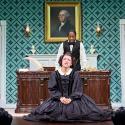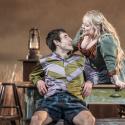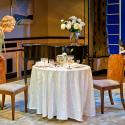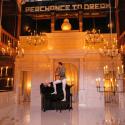The vast Avignon Festival is not a neatly curated sequence of works which can be experienced - like certain art biennales or the Proms - as if on a conveyor belt. There are 50 productions in the official “In” during three weeks, and more than a thousand shows - mostly dross - in the “Off” fringe. The festival’s directors - Vincent Baudriller and Hortense Archambault - are probably the only people to “get” the whole thing, but even they are bound to be surprised because some works evolve down to the wire (Romeo Castellucci’s presentation, for one, bears scant relation to his programme notes or even to the title of the piece).
As a punter or critic, one has the sense here of being in the mosh pit of global theatre, heavyweights like Thomas Ostermeier stamping on your toes, Steven Cohen jostling you in his illuminated corset and translucent codpiece; there is no distanced view of a whole, but rather a palpable sense of collective energy, of being part of a conversation about the purpose of theatre which is far bigger than any individual vision.
For the British press the world’s biggest theatre festival elicits barely a shrug
This is not to say the festival lacks intention: some voices are louder than others, and this year - for the first time - many of them are British. Simon McBurney - as Associate Artist - gets the biggest megaphone in the form of the Cour d’Honneur of the Papal Palace for a scaled-up version of his Barbican production of The Master and Margarita, and also has various smaller collaborations with John Berger and Juliette Binoche. On his coat-tails come Forced Entertainment and Katie Mitchell, each with two shows.
The arrival of this flotilla has been met with spectacular disinterest by the British press, for whom the world’s biggest theatre festival elicits barely a shrug, even when it tries to pay homage to Albion. This may have something to do with the fact that the artists concerned are already suspiciously foreign-leaning, enjoying international renown and co-productions (Mitchell was also here last year, and is presenting a dreamlike take on WG Sebald’s Rings of Saturn in a German-language production). All three of these creators are part of a polyglot global conversation about theatre; they have ceased to be merely Atlanticist like, say, the Royal Shakespeare Company.
 The work they are presenting here is not new-born, but this hardly matters; in Avignon’s mosh pit the work attains a new relief by bumping into others dealing with similar themes. Forced Entertainment’s The Coming Storm (pictured right by Agnes Mellon), for example, is one of several shows questioning theatre itself. Meta-theatre is nothing new, but Avignon has probably not seen before a vision which is wilfully highbrow-Brechtian while drawing on stand-up, working men’s clubs, slapstick, quiz shows and cruise ship entertainments. It is a non-story about stories, a cubist series of interruptions of the six performers’ attempts to get something on the record, to express a personal account. It begins with an incantation of the ingredients of a “good” story, most of which (we infer) will be debunked and deconstructed; this is then played out in a series of overlapping sketches about love, travel, death and crocodiles which are never quite completed; there is a rambunctious, sometimes bitter power-play between the characters. At other times one senses - in various jolly antics - the quarter-century of collective creation which underpins this wonderful and unusual group. One character states that “all [a story] has to do is to make you want to get to the next bit,” which reveals a possible fault-line in the piece: for all the laughs, inventiveness, moments of occasional tension, the show does remain a collection of “bits”, fragments or details, all at pretty much the same scale and frequency, and the audience has to work very hard to join up the dots and find their own way through the maze; I was left with a sense of coitus interruptus, despite appreciating the intention and the method.
The work they are presenting here is not new-born, but this hardly matters; in Avignon’s mosh pit the work attains a new relief by bumping into others dealing with similar themes. Forced Entertainment’s The Coming Storm (pictured right by Agnes Mellon), for example, is one of several shows questioning theatre itself. Meta-theatre is nothing new, but Avignon has probably not seen before a vision which is wilfully highbrow-Brechtian while drawing on stand-up, working men’s clubs, slapstick, quiz shows and cruise ship entertainments. It is a non-story about stories, a cubist series of interruptions of the six performers’ attempts to get something on the record, to express a personal account. It begins with an incantation of the ingredients of a “good” story, most of which (we infer) will be debunked and deconstructed; this is then played out in a series of overlapping sketches about love, travel, death and crocodiles which are never quite completed; there is a rambunctious, sometimes bitter power-play between the characters. At other times one senses - in various jolly antics - the quarter-century of collective creation which underpins this wonderful and unusual group. One character states that “all [a story] has to do is to make you want to get to the next bit,” which reveals a possible fault-line in the piece: for all the laughs, inventiveness, moments of occasional tension, the show does remain a collection of “bits”, fragments or details, all at pretty much the same scale and frequency, and the audience has to work very hard to join up the dots and find their own way through the maze; I was left with a sense of coitus interruptus, despite appreciating the intention and the method.
J érôme Bel and Theater Horta plough a similar meta-furrow, but with different results. Theater Horta are a Swiss-German troupe composed of professional actors with some form of mental disability (mostly Down’s Syndrome). The actors are instructed (by a surrogate directorial voice) to stand individually in silence facing the audience for one minute, then state their profession and their disability (this ranges from strict medical definitions to “I’m a bit slower than others”); then the seven “best” (from the group of 11) perform a dance routine of their own invention. Bel is treading a fine and dodgy line: the absent but dominant directorial voice commands and ranks performers who are sub-standard by any performing arts norms. There is a (slightly conceited) redemption when the four lesser dancers get to do their thing at the end, but, most of all, a joyous realisation that these performers, while medically typecast, are richly varied individuals, some with great natural talent despite not fitting into any of the elitist templates (beauty, skill, agility) we typically (and unthinkingly) apply to performing artists. Unlike Forced Entertainment, this show genuinely satisfies at the same time as making us address very complex and difficult questions through a deceptively simple format.
érôme Bel and Theater Horta plough a similar meta-furrow, but with different results. Theater Horta are a Swiss-German troupe composed of professional actors with some form of mental disability (mostly Down’s Syndrome). The actors are instructed (by a surrogate directorial voice) to stand individually in silence facing the audience for one minute, then state their profession and their disability (this ranges from strict medical definitions to “I’m a bit slower than others”); then the seven “best” (from the group of 11) perform a dance routine of their own invention. Bel is treading a fine and dodgy line: the absent but dominant directorial voice commands and ranks performers who are sub-standard by any performing arts norms. There is a (slightly conceited) redemption when the four lesser dancers get to do their thing at the end, but, most of all, a joyous realisation that these performers, while medically typecast, are richly varied individuals, some with great natural talent despite not fitting into any of the elitist templates (beauty, skill, agility) we typically (and unthinkingly) apply to performing artists. Unlike Forced Entertainment, this show genuinely satisfies at the same time as making us address very complex and difficult questions through a deceptively simple format.
It feels at times like a Tellytubbies snuff movie
Avignon has long sought to build interdisciplinary bridges (especially towards the visual arts) and this year is no exception, with German video artist Markus Öhrn’s first live-action work Love Story. “Live action” is perhaps an overstatement as we barely see the performers; for almost all of the show’s 200 minutes (with no interval…) they are cocooned in a translucent plastic box on stage as we watch them as if on a fixed webcam (there is also one hand-held camera). The starting point is the daughter-raping Josef Fritzl story, and we see various acts of subjugation occurring between the four (male) performers. They certainly show endurance, physical virtuosity and polyvalence; Öhrn, their imprisoner, states that his aim is to make the audience feel ill at ease, which he certainly succeeds in doing: apart from its absurd length, the show’s content leaps around (at one point the father figure becomes a Western doctor patronising poor Africans), and it is pretty one-dimensional (lots of grunting and Wikipedia-level references to fatherhood from the Bible and Hamlet); it feels at times like a Tellytubbies snuff movie. Transferring his craft from another form, Öhrn underestimates the ability of a live audience to be shocked and amused, bored and excited by small turns rather than by thick, ponderous, self-satisfied brushstrokes.
French superstar visual artist Sophie Calle, who has been given the beautiful Celestins church (main image) for an exhibition about the death of her mother, makes no such bones: she writes at the exhibition entrance that she will be performing but has no skill. In fact, by briefly reading aloud each morning from her mother’s diaries (without any former knowledge of their contents), she creates a level of attention and empathy which makes us want her to go on for hours, even days.
 Two festival regulars who are beyond category (literally creating their own weather systems) bring important new work this year. Romeo Castellucci’s promised meditation on Rothko (pictured above) is, rather, a series of sometimes violent, loosely connected tableaux vivants (10 young women cut out their tongues which are eaten by dogs; they then act out portions of Holderlin’s Empedocles until their voices vanish into recorded nothingness; we then see a series of phantasmagorical transformations of the whole stage architecture, curtains tracking backwards to reveal a dead horse and mysterious spheres, then an apocalyptic storm). Rothko can be sensed - at the third or fourth degree - in the creeping rectangular stage masks or the recordings of deep space played at the beginning; Castellucci hardly needs to prop himself up on another creator, though.
Two festival regulars who are beyond category (literally creating their own weather systems) bring important new work this year. Romeo Castellucci’s promised meditation on Rothko (pictured above) is, rather, a series of sometimes violent, loosely connected tableaux vivants (10 young women cut out their tongues which are eaten by dogs; they then act out portions of Holderlin’s Empedocles until their voices vanish into recorded nothingness; we then see a series of phantasmagorical transformations of the whole stage architecture, curtains tracking backwards to reveal a dead horse and mysterious spheres, then an apocalyptic storm). Rothko can be sensed - at the third or fourth degree - in the creeping rectangular stage masks or the recordings of deep space played at the beginning; Castellucci hardly needs to prop himself up on another creator, though.
 Joseph Nadj makes his 11th festival visit with an astonishing miniature, Atem-Breath (pictured right), in which he and dancer Anne-Sophie Lancelin cavort, slide, float, disappear, bleed and climb sheer walls and manipulate a series of mysterious objects inside a four-metre cube lit by candles, and watched by only 70 audience members. The point of departure is Dürer’s engravings such as Melancholia or Saint Jerome; there are trembling needles activated by invisible forces, ritual wax-melting and hammering, and plenty of secret compartments. The astonishing physical discipline of the performers is all the more impressive for being seen in extreme close-up; while the piece owes a fair amount to later Beckett, it creates its own atmosphere of mysterious intensity.
Joseph Nadj makes his 11th festival visit with an astonishing miniature, Atem-Breath (pictured right), in which he and dancer Anne-Sophie Lancelin cavort, slide, float, disappear, bleed and climb sheer walls and manipulate a series of mysterious objects inside a four-metre cube lit by candles, and watched by only 70 audience members. The point of departure is Dürer’s engravings such as Melancholia or Saint Jerome; there are trembling needles activated by invisible forces, ritual wax-melting and hammering, and plenty of secret compartments. The astonishing physical discipline of the performers is all the more impressive for being seen in extreme close-up; while the piece owes a fair amount to later Beckett, it creates its own atmosphere of mysterious intensity.
Nadj’s piece is one of very few which calls into question the mid-size end-stage performance format which dominates here: it is remarkable that a festival city dependent almost entirely on eclectic “found” spaces - some of which are magnificent - shoe-horns standardised productions built to tour into all these unique venues. It is perhaps regrettable that one of the most fertile aspects of British theatre - the calling into question of the stage itself - is absent in this spotlight on our creativity; home-grown companies such as Dreamthinkspeak who cross into visual art from a performance perspective could teach a thing or two to the artists smugly facing the other way here.















Add comment